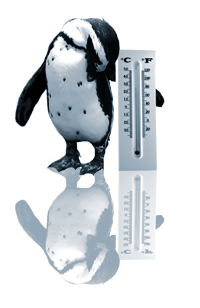Climántica :: Biblioteca
- Galego
- |
- Castellano
- |
- English
Climate change always
The Earth has constantly gone through shifts in climate occurred naturally, changing from warm to cold climates and vice versa for long periods or suddenly. In these changes, temperature has overcome the present average temperature -15 degrees Celsius- by about 8-15 degrees Celsius, preventing ice from remaining on the Poles.
Scientists distinguish two main natural causes to explain the origins of climate changes: external and internal causes. Firstly, the external causes are related to the Earth’s orbital movements and their relationship with the Sun as the planet’s main source of energy, so that its variations will influence on climate changes.
At the beginning of the 20th century the mathematician Milutin Milankovitch pointed out the main external causes of the climate’s variability.
 Milutin Milankovitch (1879-1958) was a Serbian mathematician who started his research in Belgrade University. It had soon to go away to Budapest because of the First World War. Here he started to work in the library of the Hungarian Science Academy where he researched on the ice ages’ origins. As a result of this research, Milankovitch established an astronomical theory on the relationship between the Earth’s orbital movements, the sunshine degree and the Earth’s climate.
Milutin Milankovitch (1879-1958) was a Serbian mathematician who started his research in Belgrade University. It had soon to go away to Budapest because of the First World War. Here he started to work in the library of the Hungarian Science Academy where he researched on the ice ages’ origins. As a result of this research, Milankovitch established an astronomical theory on the relationship between the Earth’s orbital movements, the sunshine degree and the Earth’s climate.
The Earth’s orbit and the shifts in climate
The orbit described by the Earth into the translation movement around the Sun is elliptic and therefore at any time during the year the planet will be nearer to it. The quantity of solar radiation falling on the Earth depends on its distance from the Sun. The Earth will receive more solar radiation on the nearest point (perihelion) to its surface than when it is more distant (aphelion).
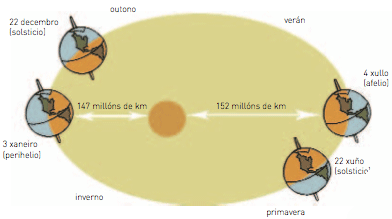
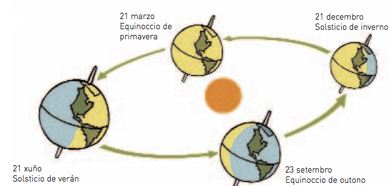
11.000 years ago, the location where seasons took place on Earth was reversed. Thus, in the North Hemisphere winter was reached during the aphelion and summer during the perihelion, so that winters were colder and summers were warmer.
Nowadays the Earth passes through the farthest point during the South Hemisphere’s winter, making it colder and the summer warmer than those from the North Hemisphere.
But due to the attraction forces exerted by other planets on the Earth, the orbit varies changing its form from elliptic to round, and these variations –called eccentricity- occur in 100 000 and 400 000-year cycles. When the orbit is strongly elliptic, the planet will pass by nearer or more distant points from the Sun.
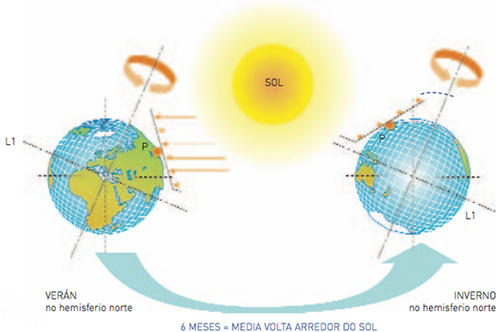
Shifts in climate due to changes in the inclination of the Earth’s rotation axis
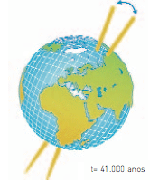 On the other hand, the Earth turns around a rotation axis that does not always keep the same inclination, called obliquity-, but it varies between 22-25 degrees Celsius -today it is 23.4 degrees Celsius-, in 41 000-year periods, making considerable changes in seasons. The greater the axis’ inclination is, the greater the seasonal changes are.
On the other hand, the Earth turns around a rotation axis that does not always keep the same inclination, called obliquity-, but it varies between 22-25 degrees Celsius -today it is 23.4 degrees Celsius-, in 41 000-year periods, making considerable changes in seasons. The greater the axis’ inclination is, the greater the seasonal changes are.
Milankovitch’s last cycle (precession) refers to the fact that the Earth moves like a spinning top around its axis because it is not a perfect sphere, so that the North Pole does not point to the Sun always at the same point of the terrestrial orbit. The precession triggers changes in climate since the position where the stations take place changes, that is, it determines if summer or winter in a Hemisphere corresponds to a point more distant or closer to the Sun. This cycle is completed every 23 000 years.
If the effects of Milankovitch’s cycle are grouped, the minimum of sunshine and the maximum of cold permitting the advance of glacial caps correspond to the farthest distance from the sun. This event occurs in December with the maximum inclination of the Earth’s axis.

The Earth’s precession movement that took place 11 000 years ago made its axis to point to the Vega star. Today it points to the Pole star.
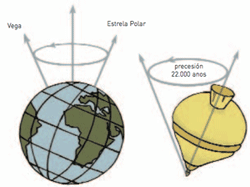
Shifts in climate due to changes in the solar activity
The solar activity and therefore the energy it releases, is not constant over the time, but it varies. The increasing energy received by the Earth will produce its warming and the same in the opposite sense. Scientists quantified the number of sunspots related to the solar activity and linked them to climate events. The more numerous these sunspots are the more radiation is released towards the Earth. Between 1645 and 1715 Europe registered very intense cold periods, during a time when the number of sunspots had diminished, called Maunder minimum, since it was the British astronomer Walter Maunder who made these observations.
By 1810, the wheat’s price rocketed in Europe as a consequence of the permanent loss of harvest due to a very cold season. These extreme climate events take place at the same time than the so-called Dalton’s Minimum, when the number of sunspots became considerably reduced.

Internal natural changes
The internal causes of climatic variability include the distribution of continents and seas, volcanic eruptions and oceanic currents:
-
The Earth’s continental mass did not remain motionless over the time, since tectonic structures have been moving around so that for about 2.5 billion years lands have joined up and separated rising mountains, opening and closing oceans. Continents have influence on oceanic currents that transport heat from Ecuador to the Poles and this has an impact on climate.
During the Triassic period, the lands raised were joined in a big continent called Pangaea, symmetrically located as regards Ecuador. This favoured an increasing number of oceanic currents carrying heat towards the Poles, and this gave way to warm climates and lack of ice on high latitudes.
-
Oceans are the main source of water vapour production in the atmosphere. They absorb the solar radiation and distribute the heat all over the planet through the sea currents. The main features of these currents are the pressure, temperature and water salinity, which condition the water density, creating density gradients both in the horizontal gradient (between high and low altitudes) and in the vertical one (surface and deep waters). The difference in density causes the main water movement in oceanic basins. The influence of wind is reduced to the first 200 metres on the oceans’ surface, generating surface currents such as the >Gulf Current, the North Atlantic Current, etc.
The figure indicates the areas represented in the sketch below 
The Pacific and Atlantic oceans are featured by a sharp contrast in temperatures between eastern and western surface waters. Trade Winds usually control the balance on the movement of warm waters from the West and the cold waters from the South American eastern coast, replacing the higher layer blew by winds. These risings make the Ecuadorian and Peruvian coast the richest in fisheries around the world. But the phenomenon called “El Niño” changes this situation. In six-to-seven-years cycles, warm waters go towards South American coasts, causing climate changes that can last several years in that area. This can be explained by the fact that Trade Winds in these cycles stop or are reduced so that the warm surface water layer does not move from the Eastern Pacific area, stopping the rising cold waters and therefore increasing the ocean’s and the air’s temperature in these areas. Water evaporation is higher and it will produce more rainfall causing floods and river rising in areas where drought is usual. Another consequence of El Niño is related to the reduction of fisheries. That lack of nutrients in waters moves fisheries southwards looking for colder waters. Air becomes warm and wet on the ocean’s surface and raises forming storm clouds in the Central Pacific. 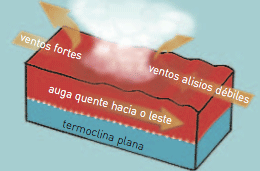
EL NIÑO / WARMING
When the eastern Trade Wind becomes weak, the western Pacific’s warm water flows eastwards. This layer which is about 150-metre deep flows into colder waters rich in nutrients, and stops its increase along the American continent. Sea life can suffer from lack of food.Storm clouds are formed over the Western Pacific’s hot waters surface. 
STANDARD
Generally speaking, Trade winds keep a balance between the Western Pacific’s warm waters and the Eastern Pacific’s cold waters, but the limit between warm and cold water rich in nutrient called Termoclina is 40 metres under the surface.
Volcanic eruptions released into the atmosphere lots of gases (CO2, SO2) producing the greenhouse effect at a regional level, and ashes and volcanic dust having an effect on the global temperature of the planet’s distant areas. In recent eruptions occurred in the Philippines's Pinatubo, the temperatures of a broad region located near the volcano increased in almost half a degree in two years.
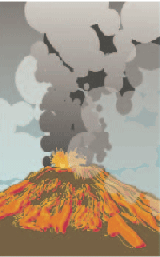
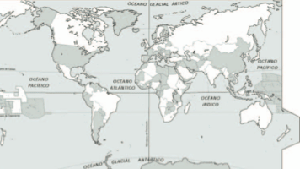
But at a global level, volcanic eruptions can cause the cooling of the atmosphere if the quantity of ashes is high and reaches the highest levels, acting as a screen for solar radiation. This was observed in the Tambora eruption in Indonesia in 1815: the following year was called the “year without summer”. Ashes reached 50 km forming a dust cloud dispersed by the wind all over the planet. This cloud hide the Sun’s light reducing temperatures for two years and damaging considerably the harvests in many regions of the North Hemisphere.
Climate changes and natural disasters
Sudden shifts in climate have sometimes caused considerable changes in the peoples’ and animals’ way of life, playing a key role in the development of ancient civilizations such as the Mayas.
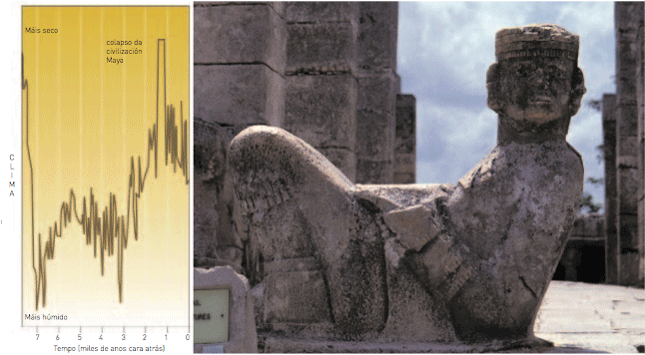
| The data taken from the study of sediments in the Mexican Yucatan Peninsula’s ancient lakes indicate that climate has changed suddenly into extremely dry conditions. | The Mayan people’s offerings to their gods were not efficient to attract the desired rain, and the adverse climate conditions caused the disappearance of the Mayan civilization 1 100 years ago. |
At the end of the 20th century the American geologists William Ryan and Walter Pitman proved that a catastrophic event took place in the Black Sea area about 7 500 years ago, that could be the origin of the Biblical story about the Noah´s Flood. By analysing in detail the data provided by intense oceanographic campaigns in this area, the Black Sea was proved to be a big freshwater lake which was not linked to the neighbouring Marmara Sea.

One of the most remarkable discoveries consisted of finding in the river bed remains of freshwater organisms covered by sea sediments containing animals adapted to salt waters.
The next step was to search for an event adapted to such changes, which was located towards the end of the last ice age, when the ice piled up started to melt and the flowing of such quantity of water over thousands of years caused a sea level rise. This process caused the Marmara Sea fall as a waterfall on the Black Sea, digging out a broad and deep channel.
This event was quick enough to move all peoples living on the lake’s shores. The flooding force is estimated to be about 200 times higher than the Niagara waterfall’s and the lake level is presumed to have increased about 100 metres in a few months.
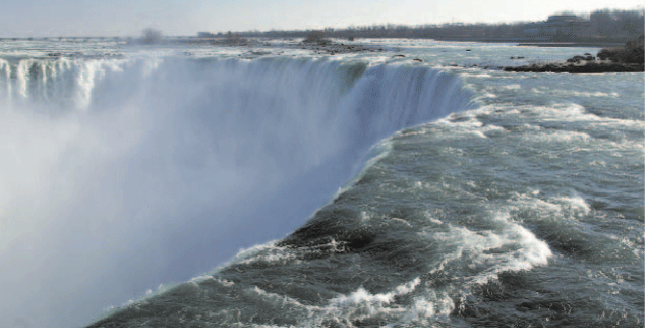
Some years later, Robert Ballard, who discovered the remains of the well-known Titanic, delimited that old coastline about 170 metres below the present one, and found under the Black Sea slopes wooden buildings, pottery and several tools proved the existence of settlings on the lake’s shores before the flooding.
Later on these peoples started to pass orally from one generation of the other the story of the Big Flood and this could possibly be its link to the origins of the Noah´s Flood myth.

The waterfall formed when preceding Mediterranean salt waters fell into the Black Sea basin caused the rising of its level at about 15 cm a day.

